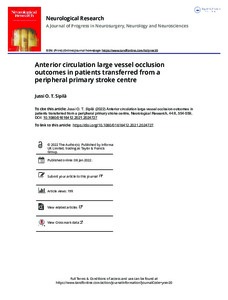Anterior circulation large vessel occlusion outcomes in patients transferred from a peripheral primary stroke centre
Sipilä Jussi OT
https://urn.fi/URN:NBN:fi-fe2022081154218
Tiivistelmä
Objectives
To identify predictors of functional outcome in patients with an anterior circulation large-vessel occlusion (LVO) in a setting of long transfer distances.
Methods
Outcomes of LVO patients transferred for an endovascular thrombectomy (EVT) from North Karelia Central Hospital to Kuopio University Hospital between January 2018 and October 2019 were analysed using retrospective patient chart review.
Results
Three months after the stroke, modified Rankin Scale (mRS) was 0-2 in 20 of the 41 transferred patients. They were younger (66.7 vs. 74.2 years, p = 0.032) and had less severe stroke symptoms (National Institutes of Health Stroke Scale, NIHSS, 11.5 vs. 16.5, p = 0.029) than those with mRS 3-6. They also had the occlusion less often in M1 and more often in M2. EVT was performed in 32 patients (no differences between those treated with EVT and those not treated with EVT). Their median age was 73.0 years (interquartile range 65.5, 79.8; range 32-86; 25% over 80), mean NIHSS score 14.0 (standard deviation 5.9) and mRS eventually 0-2 in 44%. Only NIHSS was associated with mRS (OR = 1.16; p = 0.016) in the EVT-treated patients. mRS was 0 in 38% of all EVT-treated octogenarians but 4-6 in 83% of those with an internal carotid artery and/or M1 occlusion.
Discussion
Outcomes depended on stroke severity, age and vessel of occlusion. Prognosis was worse if the occlusion included M1, especially in octogenarians. Mothership and Drip-n-ship strategies should be compared in patients from remote locations stratified by stroke severity and patient age.
Kokoelmat
- Rinnakkaistallenteet [19204]
